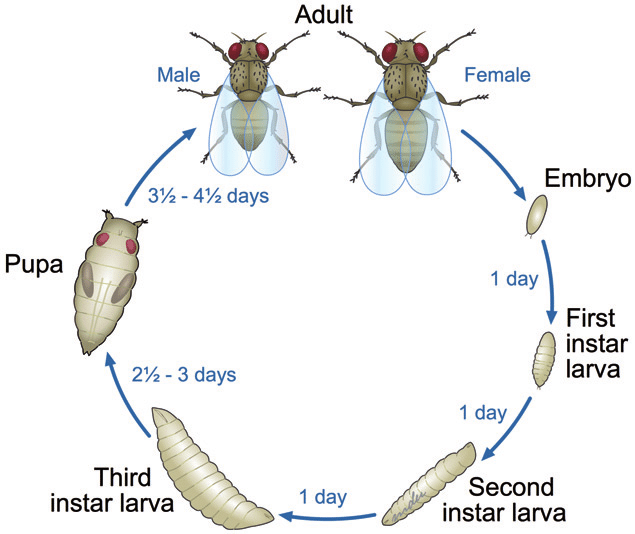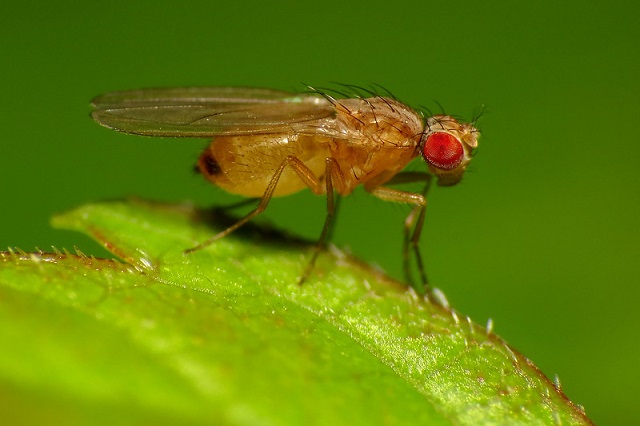It is very likely that you have noticed tiny flies surrounding fruits kept at the table, and you may have noticed that they differ from the larger house flies; they are fruit flies. Drosophila melanogaster are commonly known as fruit flies.

The name derives from ‘droso’ that means ‘dew’, ‘phila’ that means ‘liking’, ‘melano’ that means ‘black’ and ‘gaster’ that means ‘abdomen’. Essentially, these are dew loving flies with black abdomens. They are also called vinegar flies or wine flies. Fruit flies are positively phototropic and negatively geotropic. That means they are attracted towards light and that they prefer to move in the upward direction.
Who is called the Cinderella of Genetics and why?
Drosophila melanogaster is called the ‘Cinderella of Genetics’. This is because they have a life cycle of 12 days. This means that it completes it’s entire life stages from hatching from the egg to forming a larva, pupae and then into an adult within 12 days. Potentially, we could study 24 generations of these flies in a year. This is why they make a very good model to study ‘Experimental Evolution’.
What is a model system?
We cannot directly experiment on humans, hence, we experiment on other animals. They form ‘model systems’ for studies.
What makes Drosophila a good model system?
1. Drosophila melanogaster is an invertebrate, hence there are no ethical issues involved in using them for study purposes as those involved while using other model systems such as mice or zebrafish.
2. A single Drosophila female can lay about 750 eggs during its lifetime. This provides us with a very large number of offspring that we can study, which is ideal for biological studies.
3. They have a life cycle of about 12 days and a short life span of about 30-90 days.
4. The Drosophila has only 4 chromosomes which allow for easier genetic studies.
5. It is seen that 70% of the disease-causing genes in humans are shared with the genes of drosophila. This makes them good models to study diseases. Some of the diseases causing genes that are not present can be artificially introduced into Drosophila and can then be studied.
6. They can be used to test drugs and medicines which are intended for use in humans.
7. Their brain has almost 10000 neurons and can be used for studying learning and memory skills.
8. These flies are easy and not very expensive to maintain.
In the year 2017, the Nobel Prize in Physiology or Medicine was given to Jeffrey C. Hall, Michael Rosbash and Michael W. Young for their discoveries of molecular mechanisms controlling the circadian rhythm. They studied this in fruit flies.
Start Your Own Fruit Fly Culture at Home
What does the life cycle of Drosophila look like?
The life cycle of Drosophila is about 12 days at 25̊C. After the female lays eggs, they hatch out within 24 hours. Following this, they go through three larval stages, called the 1st instar, 2nd instar and 3rd instar stages.

During the first two instar stages, they focus on eating as much as they can, they become larger and fatter and build up their energy stores. During the 3rd instar stages, they slow down their eating process and staring moving upwards or towards dryer ground, to prepare for their next stage of life, that is the pupa. Through about four days of the stage of the pupa, complete adult structures such as legs, wings, head abdomen are formed, and the adult emerges out.
The female Drosophila is larger than the male.

What are imaginal discs?
Larval stages look very different from adult stages, then how do the adult structures arise during metamorphosis? There are certain structures called ‘imaginal discs’ that act as precursors to adult structures. These tiny imaginal discs are a compact layer of cells that have no function in the larval stages but take part in the formation of the adult structures.
They sound like ‘imaginary discs’ but, the word derives from ‘imago’ which means the image of the adult. There is a leg imaginal disc that will form a legs, wing imaginal disc that will form a wing, ‘eye antennal imaginal’ disc that will form the eye and antennal structures etc.

How and what does Drosophila eat?
Drosophila has a mouthpart called a proboscis, that it uses to drink up liquids from foods. These foods may be anything that is soft, like rotting fruit that gives out odour.
How does Drosophila see?
Once you look closely at the fly, the most distinguishing feature you will see are its large eyes. These eyes are called compound eyes which consist of about 800 tiny units called ommatidia.
Watch Fruit Flies Help us Understand Human Responses to Micro gravity
Read about 7 Fascinating Facts About Fruit Flies
References & Citations
Ong, Cynthia & Yung, Lin-Yue & Cai, Yu & Bay, Boon-Huat & Baeg, Gyeong. (2014). Drosophila melanogaster as a model organism to study nanotoxicity. Nanotoxicology. 9. 1-8. 10.3109/17435390.2014.940405.
https://www.yourgenome.org/facts/why-use-the-fly-in-research
http://modencode.sciencemag.org/drosophila/introduction
Molecular & Developmental Biology (BIOL3530) with Dr. Brian E. Staveley, Department of Biology, Memorial University of Newfoundland
Get stories like this one in your inbox: Sign up for our email and Subscribe Now To Get The Most Anticipated Edition Of Starry Stories Magazine For Free.
Read more Articles from Life Sciences
1. Read about CRISPR Gene Editing Explained for Kids
2. Read about the Did You Just Spot a Cheetah a Leopard and a Jaguar
3. Read about the The Secret Lives of Tardigrades
4. Read about the Chlorophyll and Haemoglobin – An Unlikely Connection
5. Read about the What is the True Colour of the Coronavirus?
6. Read about Why Do Fish Not Freeze in Cold Water?
About Author
Saunri Dhodi Lobo is pursuing M.Sc in Life Sciences with specialization in Neurobiology. Her interests include writing poetry, going for nature walks and swimming. Currently she is involved in research on Alzheimer’s Disease in fruit flies.
Read all Articles by Saunri Dhodi Lobo

